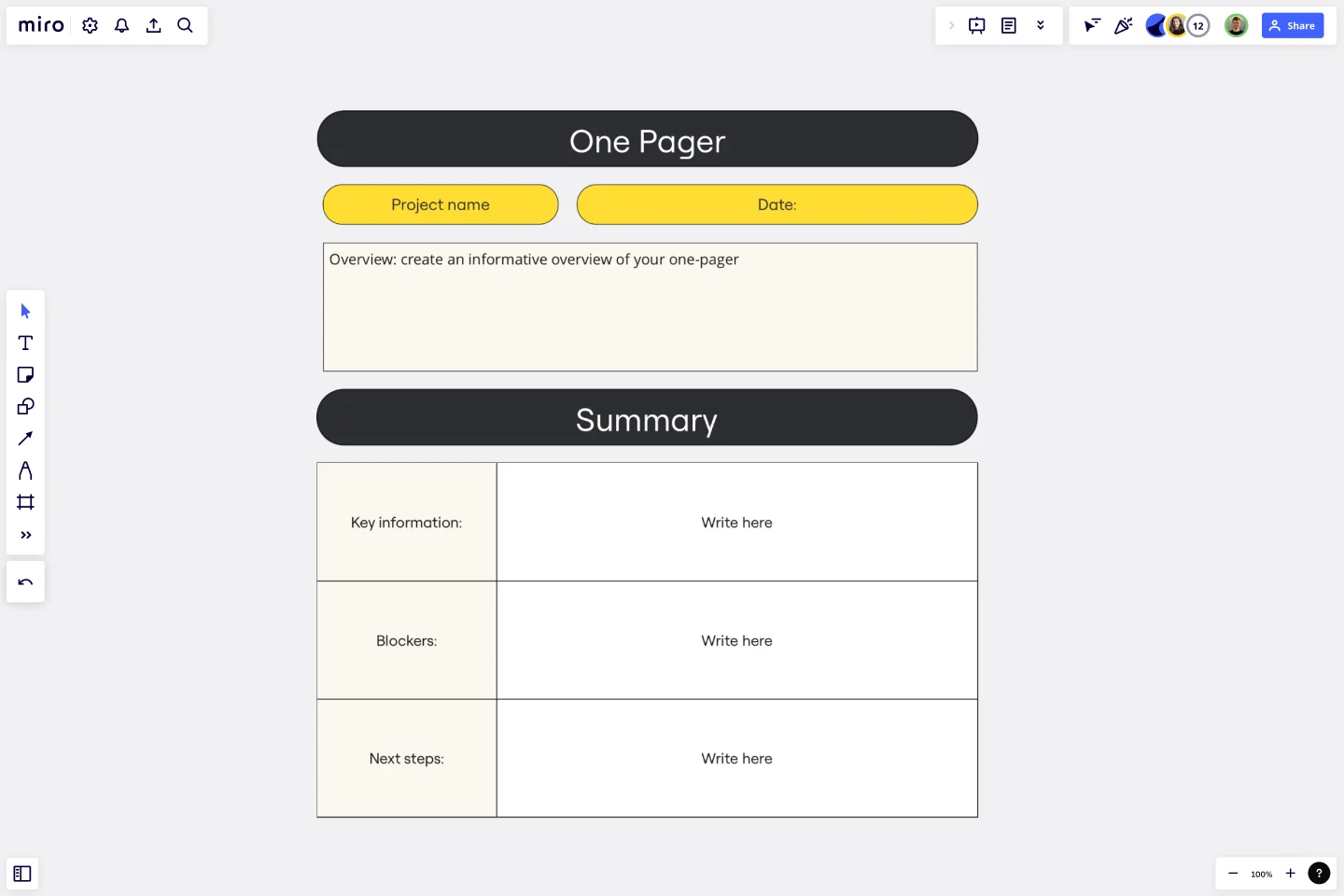One Pager Template
Communicate effectively with stakeholders with the one-pager template. Transform they way you lead projects and increase efficiency, aligning teams quicker than ever.
Trusted by 65M+ users and leading companies
About the One Pager Template
The one-pager template is a prime example of clarity and conciseness amidst the complexity of projects and data. It serves as a snapshot of ideas, plans, or projects in a compact format that is easy to comprehend. The document's main objective is to present essential information on a single page, ensuring everyone involved can quickly grasp the project's core objectives and stay aligned.
The one-pager template is an adaptable tool that encapsulates key elements of a project or topic into a concise, one-page document. The template typically includes:
Overview: This brief description offers a snapshot of the discussed project or subject.
Date: This refers to the relevant date or timeframe of the information presented. Summary
Key information: This section summarizes the most important data, insights, or outcomes.
Blockers: This section identifies any current or potential obstacles that could impede progress.
Next steps: This outlines immediate actions or future plans to continue the momentum.
Using these areas effectively allows people to quickly communicate essential aspects, providing a high-level understanding without overburdening with details.
How to use the one-pager template in Miro
To ensure a clear and concise one-pager, follow these steps:
Briefly summarize your project or idea in the Overview section.
Include the relevant date to provide context and anchor your one-pager in time.
Focus on the most critical information in the Summary area.
Identify any challenges or blockers to encourage proactive problem-solving.
In the Next Steps section, outline the immediate and future actions to guide your team.
Customizing the template is incredibly easy. Modifying the content to meet your specific requirements takes only a few clicks, just double-click sections and edit fields in the context menu bar. If necessary, you can effortlessly expand the template by adding new sections.
Why should you use a one-pager template?
Efficiency: It conveys critical information quickly without the need for lengthy explanations. Clarity: It provides a clear and concise format that highlights the most important aspects of a project. Alignment: It keeps everyone on the same page, literally and figuratively, reducing the risk of misunderstandings. Focus: It helps teams focus on key objectives, blockers, and next steps without getting lost. Versatility: It can be used for various purposes, from project summaries to proposal outlines, making it a go-to resource for many needs.
Can the one pager template be customized?
The template is designed to be flexible and can be customized to fit the specific needs of any project or initiative.
Is the one pager template suitable for all industries?
The adaptable template can serve various industries and departments, from marketing to product development.
How should I prioritize information on the one pager?
Prioritize information based on its importance to the project's objectives. Key information that directly impacts decision-making should be most prominent.
Can I share my one pager with external stakeholders?
The one pager is an excellent communication tool with external stakeholders. It's designed to be easily understood, even by those with limited background on the project.
Get started with this template right now.
PERT Chart Template
Works best for:
Mapping, Project Planning
A Program Evaluation and Review Technique (PERT) diagram is used to plan projects efficiently. They help you set a clear timeline, plan out tasks and dependencies, and determine a critical path.
Risk Assessment Template
Works best for:
Leadership, Project Management, Decision Making
Every business faces risk. The more you factor it into your decisions early on, the better prepared you’ll be to avoid, absorb, or mitigate the risks you encounter. Use Miro’s risk assessment template to collaborate on a clear-eyed risk assessment that ensures you’ll never be caught unawares.
Cynefin Framework Template
Works best for:
Leadership, Decision Making, Prioritization
Companies face a range of complex problems. At times, these problems leave the decision makers unsure where to even begin or what questions to ask. The Cynefin Framework, developed by Dave Snowden at IBM in 1999, can help you navigate those problems and find the appropriate response. Many organizations use this powerful, flexible framework to aid them during product development, marketing plans, and organizational strategy, or when faced with a crisis. This template is also ideal for training new hires on how to react to such an event.
Visual Story Map Template
Works best for:
Marketing, Desk Research, Mapping
Some people like to think of a visual story map as a stylized to-do list, but it’s a lot more powerful than that. Visual story mapping allows your product management team to visualize multiple dimensions of information.
Year Timeline Template
Works best for:
Timeline, Planning
The Year Timeline template provides a comprehensive view of annual events and milestones. Perfect for planning yearly goals, tracking progress, and scheduling important dates, this template helps you stay organized and focused throughout the year.
Team Meeting Agenda Template
Works best for:
Documentation, Team Meetings, Workshops
Making the time for your team is important to help you to make decisions, align on priorities, and move in the same direction together. Team meeting agendas help add a schedule and structure to your allocated time slot when you need to share information and collaborate with your team. They also allow your team to agree on goals, talking points, action items, and who will lead the next steps. Uninterrupted team meeting time with an agenda can help your team review progress against OKRs, share updates, discuss roadblocks, and brainstorm ideas.
